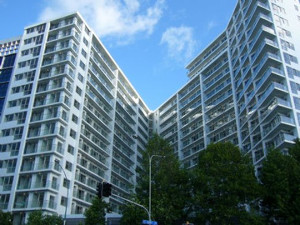Guidelines for Covid-infected people living in apartments
The Health Ministry has issued new advice for body corporates dealing with Covid-19 infected people self-isolating in their apartments.
Monday, November 29th 2021, 7:49AM
by Sally Lindsay

The guidelines comes after The Body Corporate Chairs Group (BCCG) said thousands of inner-city apartments were not safe for Covid-19 isolation after two people died while isolating in their apartments.
The guidance is the first clarification of how self-isolation should work in apartments. About 40,000 people live in Auckland CBD apartments.
It includes a series of recommendations, and a checklist, for body corporates and apartment dwellers to follow should a positive case of Covid-19 be in the building. Bodies corporate cannot refuse permission for people to self-isolate in apartments, the ministry says. Discrimination is unlawful.
The checklist asks bodies corporate to list the number of floors, if they have contact details for residents and staff, how many people live in the building, what the vaccination status is of all contractors and staff and, if there is adequate PPE gear.
For deliveries, these should be left outside doors and only collected when the delivery person has left and no one is passing by.
Building exit and entry points
A body corporate committee may consider setting up separate exit and entry points in and out of the building to minimise contact where possible.
Foyer and waiting areas
Social distancing of one-metre should be encouraged for entry foyer and waiting areas. Removing seats from lobbies or waiting areas to discourage people from congregating there should be considered. Where seating is required, space it at least one-metres apart.
Lifts and stairwells
Residents should be instructed to not use the lifts or stairwells with others if they are undergoing self-isolation.
For other residents, they should be encouraged to maintain minimum of one-metre physical distancing while waiting for a lift and once in the lift or limiting the use of the lift to one person at a time.
Floor markings could be used at lift entrances to prompt users to maintain physical distancing while waiting for the lift and encourage one-way flow to avoid bottlenecks occurring near lift entrance points.
Signage installed at lift entrances recommending a maximum number of people who should enter a lift to maintain one-metre physical distancing can be used to help maintain physical distancing.
Gardens and courtyards
It is recommended that these areas are not accessed at any time by any person undertaking self-isolation.
For other residents communal gardens can remain open as a place to exercise and get fresh air.
Recreation and exercise restrictions do not apply to residential premises, however the number of people in these areas should adhere to current visitor restrictions.
Other common areas
These areas should not be accessed at any time by any person undertaking self-isolation.
Otherwise, Increasing ventilation of common areas to reduce the risk of Covid-19 transmission by opening windows or leaving doors open (where safe to do so) can help to reduce the risk of Covid-19 transmission is recommended under the guidelines.
Where common areas such as gyms, indoor pools or saunas are kept open, resident safety can be supported by clearly signposting capacity limits and requiring them to scan in using the NZ
Covid tracer app
Cleaning frequently touched surfaces such as intercom and lift buttons, hand railings and common area door handles regularly with disinfectant can reduce the spread of germs between residents.
Closure of facilities may need to be considered if capacity numbers are not able to be managed, or adequate cleaning between use is not possible.
Ventilation
If any resident is self-isolating, they should be encouraged to seal the gaps under doors, for example using a towel, as this could decrease the leakage of air into shared spaces, like hallways and lift lobbies of the building.
The guidelines say ventilation is important as this will prevent the build-up of virus in the air by exchanging stale inside air for fresh outside air.
Air from an apartment will usually flow out of an apartment every time the door is opened, so decreasing the number of times a door is opened and keeping the amount of virus in the air to a minimum, will decrease the risk of infection for anyone else living in the apartment building.
Opening windows in apartments that do not have centralised mechanical ventilation system can be an effective method of exchanging inside air for outside air. Being able to open windows on two opposite sides of a room is particularly effective at ventilating a room by creating a flow of air from one side of the room to the other.
Using exhaust fans in the kitchen or bathroom is also an effective way of ventilating a room. However, most bathroom and kitchen fans are not designed to be run continuously.
In an average sized apartment, opening a window for 15 minutes will be sufficient to ventilate the apartment and introduce fresh, outside air and reduce the risk of Covid transmission.
Leaving windows open will provide continuous ventilation. If it is not possible to leave windows open in the apartment over a period, it may require to be ventilated two or three times a day depending on the size of the apartment and the level of occupancy. If the apartment starts to smell, then that is an indicator of poor air circulation and will be time to open some windows.
Buildings with HVAC systems
HVAC modifications which may decrease the risk of COVID-19 infection include using as much fresh air as possible and filtering the air.
Most HVAC systems will use a combination of fresh and recycled air. Using 100% fresh air is the best way to remove virus from a room because the virus because fresh air from outside will not contain any virus. Recycling air, recycles the virus with it, introducing fresh air as much as possible, will remove the virus.
It is important to ensure that recycled air is not shared between apartments. HVAC systems with central air filters may be used to remove virus. However, the filters necessary to remove viruses are usually only used in hospitals or other areas that require very high-quality air. Several international organisations have provided guidance for modifications to HVAC systems to decrease the risk of infection.
Air cleaning technologies
Air cleaning devices, such as High Efficiency Particulate Air (HEPA) filters can be used to remove a wide range of pollutants or infectious organisms from the air without exchanging stale air for fresh air. These technologies can be used as part of an HVAC system, in addition to an HVAC system or instead of an HVAC system.
However, these devices can be expensive and currently are difficult to obtain due to high world-wide demand. Therefore, these devices may not be a suitable option for many apartment buildings.
High efficiency particulate air (HEPA) Filters
HEPA filters can remove most viruses. Filters are rated by the proportion of particles which are removed from the air using a standard called the Minimum Efficiency Reporting Value (MERV).
The higher the MERV rating, the better the filter is at removing virus. Filters with a MERV rating of 13 or more can remove airborne viruses. HEPA filters have a MERV rating of more than 16 MERV.
Physical barriers
Engineering controls, such as erection of physical barriers and dedicated pathways can be used to reduce or eliminate exposure of others in the building, including those self-isolating with COVID-19.
Balconies
For cases self-isolating, it is advised to have the doors to the balcony open to allow the circulation of air into the apartment.
However, residents self-isolating should not be on the balcony whilst other residents are on their balconies that are within two-metres.
Rubbish chutes and waste areas
A body corporate committees should consider placing hygiene stations with hand sanitiser near waste areas or rubbish chutes and encourage residents to wash and sanitise their hands after using waste facilities. Self-isolating residents should get family members or friends to get their rubbish. They should double-bag it and put it outside their doors when no one is around.
Cleaning, construction, repairs, maintenance, and safety
Within a general area, workers may enter a place of residence as well as common property to carry out work. If possible, the premises should be unoccupied while the work is being carried out. Tradespeople must wear the appropriate PPE, scan using the NZ Covid tracer app and maintain good hygiene.
It is recommended a supply of emergency face masks are kept near the building’s emergency assembly point in case residents have not been able to evacuate with their own.
Property inspections and auctions
None of these is to be carried out in the apartment of a case self-isolating.
In general areas, property inspections and auctions can occur in accordance with general density limits. Property inspections for the purpose of sale or lease should be carried out by appointment only, and with only one person inspecting the premises at a time.
Auctions can be carried out within the capacity limits, maintaining one-metre physical distancing and wearing of face coverings, including scanning using the Covid tracer App.
| « Tower's flood modelling to change premiums | How cities need to change to adapt to climate change » |
Special Offers
Comments from our readers
No comments yet
Sign In to add your comment
| Printable version | Email to a friend |



